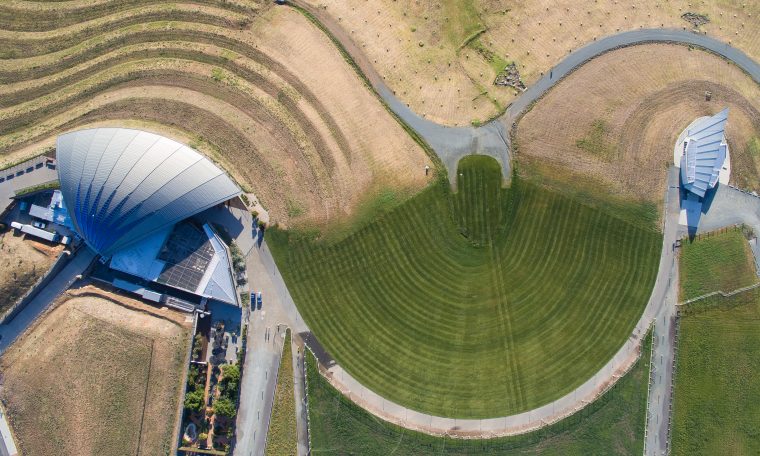In 2018 Canberra was Australia’s second-fastest growing city, pipped by Melbourne by 0.3%, with Brisbane in third. That trend continues. Shouldn’t be a problem to keep on expanding, the Australian Capital Territory is pretty big? Actually, it is a problem. The territory is mostly too rugged for development, and 60% of the land is already locked away in national parks and reserves. Take a look at the city map and the growing pains are clearly seen, with suburbs hemmed in by the Territory’s borders on all sides except to the south west. Infill development is one way the government has gone about accommodating the influx of people, with residential towers rapidly popping up in the city and town centres. But the government has pushed ahead with large-scale “greenfield” development as well, despite the cost.
Growing pains
Expansion of Canberra outwards instead of upwards, where there’s not much space before you trip over the border into New South Wales, raises serious issues. Now, the two jurisdictions – ACT and NSW – have to work out who pays and who profits as houses of people who think they live in Canberra spill over into NSW. You can expect that the ACT has no incentive to do anything for NSW unless it is paid, and NSW has no urban centre or amenities nearby in order to provide the services city-slickers expect. The issues at stake extend to things like the enhancement of land values; environment, heritage, planning and development; the provision of city services; policing and the regulation of crime, and all of the other regulatory necessities that make a city run smoothly.
Straddling the border
Enter “Ginninderry”, an area to the west of the existing Canberra township of Belconnen, named after the creek that flows through it. The developers – jointly the government, and a private landowner – have just released Ginninderry Stage 2, comprising 122 blocks. Consistent with present trends, the blocks are mostly quite small, but are intended for single detached housing. The larger development of which this land release is part is intended to cross into NSW’s Yass Valley, and is projected to have 11,500 dwellings and a population of 30,000 by 2055. About half of those houses are supposed to be in what is presently “Parkwood”, in NSW.
How is this going to work, in legal terms? Early reports claim that NSW would not relinquish any control of the development approvals required, or of the value of the land. So, for example, residents face the dilemma of different land registration systems and stamp duties as between properties which neighbour each other but are in different jurisdictions and, failing a very high level of cooperation, different housing and construction requirements as well. It has also been said that Yass Valley Council would collect ACT-level rates from Parkwood residents, and pay the ACT to provide ACT-side services to those residents, such as waste collection and emergency services.[1] There is also a proposal for ACT police to apply ACT law in Parkwood, described strangely as a “legal buffer zone”.[2]
To add to the confusion, NSW rural landowners have expressed doubts that the borders will remain in place, fearing that they will be moved into the ACT when the NSW government realises it needs more water for Parkwood and other nearby towns. Who has that water? Those well-off Canberrans, of course.[3]
Living on a political fault line
The problems faced by border-dwellers are not new, but they have been getting more airplay as Australian border towns become more urbanised. To deal with these issues, jurisdictions like NSW have appointed “Cross-Border Commissioners” and other responsible officers. Indeed, the ACT and NSW have a Memorandum of Understanding for Regional Collaboration in place, first signed in 2011 and revived in April 2016, and with a three year review date.[4] The MOU is very high level, emphasising the need for collaboration rather than separation, shared funding and a “person-centred” approach to service provision.
The Victorian Liberal National Party made an election issue of cross-border problems last year, pointing out in a media release that “[a] lot changes when you travel across the border and for our business owners and residents in border communities this is an added complication to everyday life”, that service trades need to get two licences, and that it is harder for “police officers and emergency services to share the information they need to do their job”.[5]
People survive, but it is the quality of the survival that matters. The communities living in Tweed Heads know all too well about the pitfalls of “time travel” between NSW and Queensland, with NSW on daylight saving and Queensland not. How to navigate living in a suburb with different authorities with overlapping or separate responsibilities for each aspect of your everyday life is certainly something that most of us would want to avoid. The application of the same laws in both places is the best way to address these concerns.
Do lawyers have a solution?
Media reports thus far suggest that three approaches are under consideration. The first is the maintenance of different laws, with a collaborative veneer at the administrative and operational level. To us this would only paper over some very large cracks, and not for very long.
At the other extreme, the border could simply be moved, such that the ACT is extended into NSW the required distance. In our view this would be fantastic, but in the “fantasy” sense of the word. It is not apparent that any red-blooded State would be happy to hand over large tracts of land to its neighbour, nor do I think the ACT could afford to “buy” something that ordinarily would need to be conquered.
The third way would be to legislate for ACT law to operate in Parkwood, as absolutely as possible, such that there truly were no differences in the treatment of the residents.
“Barr the Conqueror”
Not everyone agrees with our view that “annexation” is unlikely. ACT Chief Minister Andrew Barr says that “it’s fundamental that the border move”.[6] Although this would indeed resolve the complexities that would otherwise attend living in the Ginninderry development, the legal process itself underlines the political problems that would be encountered.
The NSW Parliament would first have to pass legislation surrendering its sovereign title to the land. The Commonwealth Government would then need to accept the land via its own legislation, and then “grant” it to the ACT, but only in the sense of obliging the ACT to manage and be responsible for the land, and to receive the rents and profits therefrom. We say this because ACT land is “owned” by the Commonwealth, and “management and responsibility” is the current model by which the ACT governs “its” land. To grant Parkwood directly to the ACT would be possible but in our view would create a complicating “third kind” of land title – not that of NSW, and not that of the Commonwealth – where there had previously only been two.
The Commonwealth would then give the ACT Legislative Assembly the power to make laws for the peace, order and good government of the people of Ginninderry, in the same way as it has allowed the ACT the power to govern itself since 1988 when the Australian Capital Territory (Self-Government) Act 1988 was enacted.
Yes, this would afford jurisdictional certainty to the residents in their day-to-day lives. But, because of the land devolution and the number of governments that would need to be involved, we do not see it happening.
Looking after something you don’t own
What if Parkwood was to be “governed” by the ACT, even if NSW does not agree to hand over the land? Does Canberra’s “beachfront”, 200 kilometres away down at Jervis Bay, serve as some kind of precedent?
Jervis Bay is often referred to as part of the ACT. It is a small patch of land, originally intended to give the land-locked “seat of government” of Australia, which is Canberra, a naval port. It is not really correct to say that it is part of the ACT. It was ceded to the Commonwealth by NSW, in two steps. First, the land was granted in 1909, and then in 1915 it was entirely surrendered to the Commonwealth, the difference being that the surrender constituted an abdication of any sovereign power of the NSW Parliament over the land.
Already, we can see that Jervis Bay is not “like” the Parkwood situation, because our starting assumption is that Parkwood would not be given away by NSW, whereas Jervis Bay was. But there is something analogous about Jervis Bay that might assist in working out what to do with Parkwood. This is because although Jervis Bay is Commonwealth land, under the Jervis Bay Territory Acceptance Act 1915, “the laws… in force from time to time in the Australian Capital Territory are, so far as they are applicable to [Jervis Bay] and are not inconsistent with [other Commonwealth regulations], in force in [Jervis Bay]”.
The situation causes a lot of confusion, not the least part of which is the difficulty of working out which ACT laws do apply. This was considered in the Wreck Bay case, which was decided by the High Court in February of this year. [7] Wreck Bay confirmed that ACT law (in that case the Residential Tenancies Act 1997) is capable of operating concurrently with Commonwealth legislation in the Territory. Resultantly, Jervis Bay residents, who do not live in the ACT, do not vote in local ACT elections, and do not lease land from the ACT, nonetheless can have a dispute about their lease heard under ACT legislation in an ACT tribunal.
The question of working out when and how ACT law applies can be complicated. Here at Moulis Legal we have been called upon to advise on whether the ACT has the ability or indeed responsibility to licence major utilities in Jervis Bay, or to police local drivers, or to regulate and approve land uses. The progress of the Wreck Bay case all the way to the High Court indicates that these are not easy tasks.
Having your cake even if someone else is eating it
The creation of the Australian Capital Territory as a body politic by the Commonwealth in 1988 includes an enumeration of the matters concerning which the ACT Legislative Assembly can make laws and pursuant to which the ACT Executive can govern the Territory. But “the Territory”, when used in a geographic sense, does not include Parkwood.
But the Commonwealth usefully bestowed on the ACT body politic the responsibility for “exercising such other powers as are vested in the Executive by or under…an agreement or arrangement between the Territory and… a State”. Accordingly, even within the constraints of the ACT’s limited sovereignty, it should be possible for NSW and the ACT to come to an arrangement about the ACT’s governance of Parkwood. And the Jervis Bay example would be useful, because it tells us that legal ambiguity is best avoided.
In that way, with a bit of pro-active thinking, the political obstacles involved in “giving away” land without a fight would be avoided, and the objectives of uniformity of regulation, consistency of services and standards, and ease of life could be achieved on both sides of Ginninderry Creek.
This memo presents an overview and commentary of the subject matter. It is not provided in the context of a solicitor-client relationship and no duty of care is assumed or accepted. It does not constitute legal advice.
© Moulis Legal 2019
[1] https://www.canberratimes.com.au/story/6005341/new-cross-border-development-residents-may-have-to-pay-act-level-rates/
[2] https://www.canberratimes.com.au/story/6004965/border-move-fundamental-to-cross-border-ginninderry-development/
[3] https://the-riotact.com/yass-buffer-zone-freeze-leaves-border-landholders-out-in-cold/287885
[4] It is reported that “The ACT Government is currently renegotiating the MOU, to be re-signed in 2019”. See comments to recommendation 8 in the following: https://www.health.act.gov.au/sites/default/files/2019-05/Government%20Response%20to%20the%20Final%20Report%20of%20the%20Independent%20Review%20into%20the%20Workplace%20Culture%20within%20ACT%20Public%20Health%20Services.pdf
[5] http://vic.nationals.org.au/liberal_nationals_commit_to_tackling_cross_border_problems
[6] https://www.canberratimes.com.au/story/6004965/border-move-fundamental-to-cross-border-ginninderry-development/
[7] Williams v Wreck Bay Aboriginal Community Council [2019] HCA 4


